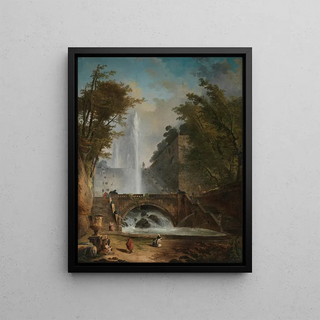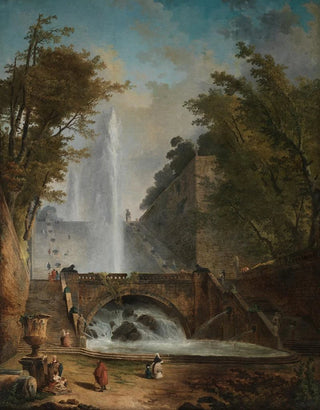Art print | Staircase and fountain in the park of a Roman villa - Hubert Robert


View from behind

Frame (optional)
Roman villa garden and fountain art print by Hubert Robert – Captivating introduction
The artwork "Roman villa garden and fountain" by Hubert Robert immerses us in a universe where nature and architecture harmoniously coexist. This piece, a true ode to the beauty of Roman gardens, invites viewers to stroll through a space where time seems to stand still. The elements composing this scene are carefully arranged, creating an atmosphere of serenity and escape. As you contemplate this art print, you can almost feel the gentle breeze caressing the leaves of the trees while hearing the soothing murmur of the fountain’s water. This piece is a genuine window into a dream world, a place where one longs to lose oneself.
Style and uniqueness of the art print
Hubert Robert’s style is characterized by finesse in execution and a keen attention to detail. In "Roman villa garden and fountain," he manages to capture the very essence of 18th-century Italian gardens. The shades of green, the play of light and shadow, as well as the delicacy of the forms, testify to a sharp sense of observation and undeniable technical mastery. The majestic staircase ascending towards the fountain becomes the focal point of the composition, drawing the eye and encouraging further exploration of the space. The arrangement of elements, the harmony of colors, and the realistic depiction of textures all contribute to bringing this scene to life, transforming it into an almost tangible tableau. The art print stands out for its ability to evoke a sense of peace and contemplation, an invitation to escape.
The artist and his influence
Hubert Robert, often nicknamed the "painter of ruins," left his mark on his era with his unique approach to landscape art. Born in Paris in 1733, he was influenced by the great masters of the past while developing a personal style that combines romanticism and classicism. His passion for antiquity and admiration for nature are reflected in his works, where he manages to infuse poetic dimension into scenes of everyday life. His influence extends beyond his time, inspiring many artists who followed

Matte finish

View from behind

Frame (optional)
Roman villa garden and fountain art print by Hubert Robert – Captivating introduction
The artwork "Roman villa garden and fountain" by Hubert Robert immerses us in a universe where nature and architecture harmoniously coexist. This piece, a true ode to the beauty of Roman gardens, invites viewers to stroll through a space where time seems to stand still. The elements composing this scene are carefully arranged, creating an atmosphere of serenity and escape. As you contemplate this art print, you can almost feel the gentle breeze caressing the leaves of the trees while hearing the soothing murmur of the fountain’s water. This piece is a genuine window into a dream world, a place where one longs to lose oneself.
Style and uniqueness of the art print
Hubert Robert’s style is characterized by finesse in execution and a keen attention to detail. In "Roman villa garden and fountain," he manages to capture the very essence of 18th-century Italian gardens. The shades of green, the play of light and shadow, as well as the delicacy of the forms, testify to a sharp sense of observation and undeniable technical mastery. The majestic staircase ascending towards the fountain becomes the focal point of the composition, drawing the eye and encouraging further exploration of the space. The arrangement of elements, the harmony of colors, and the realistic depiction of textures all contribute to bringing this scene to life, transforming it into an almost tangible tableau. The art print stands out for its ability to evoke a sense of peace and contemplation, an invitation to escape.
The artist and his influence
Hubert Robert, often nicknamed the "painter of ruins," left his mark on his era with his unique approach to landscape art. Born in Paris in 1733, he was influenced by the great masters of the past while developing a personal style that combines romanticism and classicism. His passion for antiquity and admiration for nature are reflected in his works, where he manages to infuse poetic dimension into scenes of everyday life. His influence extends beyond his time, inspiring many artists who followed






